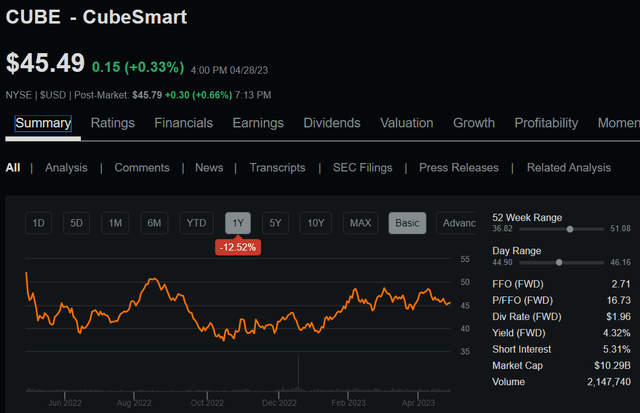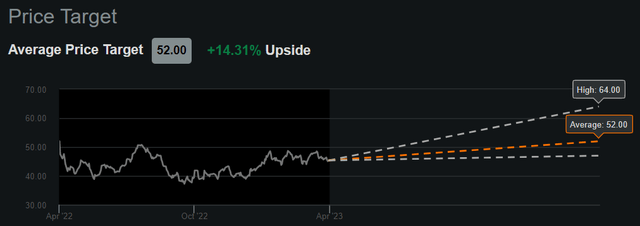Market timing can be hard, and I don’t know anyone who’s been able to do it successfully over time. That’s why a better strategy may be to layer into attractively priced stocks at regular intervals rather than waiting for a crash that may never come.
This brings me to CubeSmart (NYSE:CUBE), which I last covered here back in December, highlighting its well-located portfolio and attractive valuation. The stock has given investors a respectable 6.5% total return since then, nearly double the 2.9% rise in the S&P 500 (SPY) over the same timeframe.
It still remains attractive, though, considering its dip for the near-$50 level in early April and remains down by 13% over the past 12 months, as shown below. In this article, I highlight recent developments and discuss why it’s attractive for income and potentially strong long-term returns, so let’s get started.
Seeking Alpha
Why CUBE?
CubeSmart is one of the top 3 self-storage REITs in the U.S. with 1,279 properties. What sets CUBE apart from other self-storage REITs is the fact that it also has a 3rd party management platform, through which it manages properties for private owners, thereby resulting in a steady source of fee revenue.
CUBE is diversified across 39 states, operating in 153 markets, and 89% of its owned stores are located in the Top 40 metropolitan statistical areas in the U.S. It has 712K customers and no single tenant or cohort represents a material segment of CUBE’s rent roll.
Meanwhile, CUBE continues to demonstrate strong results, with same store net operating income growing by an impressive 9.1% YoY during the first quarter. This was driven by positive operating leverage in which revenue growth of 7% far outpaced the 1% growth in operating expenses. CUBE also added 25 stores to its third party management platform during the quarter, bringing its total 3rd party managed store count to 676.
Notably, CUBE is enjoying a sticky existing customer base, as vacates during Q1 were down by 3.3% from the prior year period, and down even further by 9.5% when comparing to the pre-pandemic first quarter of 2019. 48% of CUBE’s customers has been with them for over two years, up 230 basis points from the same period last year, and same store occupancy also remained strong at 91.9% as of March 31st. This gives management a stronger base on which it can raise rents.
Potential headwinds to CUBE include the below average growth in some markets such as Washington D.C., Virginia, Maryland, and Arizona, where COVID-induced migration has waned. This was offset by above average growth in Florida, Texas, and Southern California. However, management is being cautiously optimistic, as the demand momentum it saw in the first two months of the year slowed in March, only to kick back into gear in April.
Meanwhile, management is also being disciplined with external growth opportunities in the current environment, with deal volume that’s down by 30% compared to the same prior year period. This is due to unattractive pricing with not as many high quality opportunities as it saw over the past couple of years.
Nonetheless, CUBE maintains a strong balance sheet, making it well-positioned to pursue opportunities when bid-ask spreads on property acquisitions improve. This is reflected by its BBB credit rating and low debt to EBITDA ratio of 4.4x. 98% of CUBE’s debt is fixed rate and it has an average debt maturity of 6 years.
The investment grade credit rating and low leverage should enable CUBE to secure favorable pricing on debt as it matures compared to lower-graded borrowers. Plus, the market now expects just a quarter point hike at the Fed’s next meeting with potential for 50 bps in rate cuts by the end of the year, which would reduce the cost of borrowing for REITs (VNQ) such as CUBE.
Importantly for income investors, CUBE pays a respectable 4.3% yield and the dividend is well covered by a 75% FFO payout ratio. It also comes with an impressive 5-year dividend CAGR of 10% and 12 years of consecutive growth.
Lastly, while CUBE is no longer cheap at the current price of $45.49 and forward P/FFO of 16.8, it’s not expensive either, as this sits below its normal P/FFO of 18.7. This is also considering CUBE’s 12% YoY FFO per share growth during the recently closed quarter and its strong balance sheet with potential for accretive growth over the long run. Analysts have a consensus Buy rating on the stock with an average price target of $52, implying potential 19% total return over the next 12 months.
Seeking Alpha
Investor Takeaway
In summary, CubeSmart’s impressive first quarter results are indicative of its resilience amidst economic adversity and demonstrates why it is an attractive REIT for income and growth investors alike. Its long-term growth prospects remain solid despite the headwinds in some markets while the strong balance sheet gives management flexibility to pursue external growth opportunities when attractive opportunities arise. Meanwhile, it pays a respectable yield and remains attractively priced for potentially strong total returns over the long run.
Read the full article here












